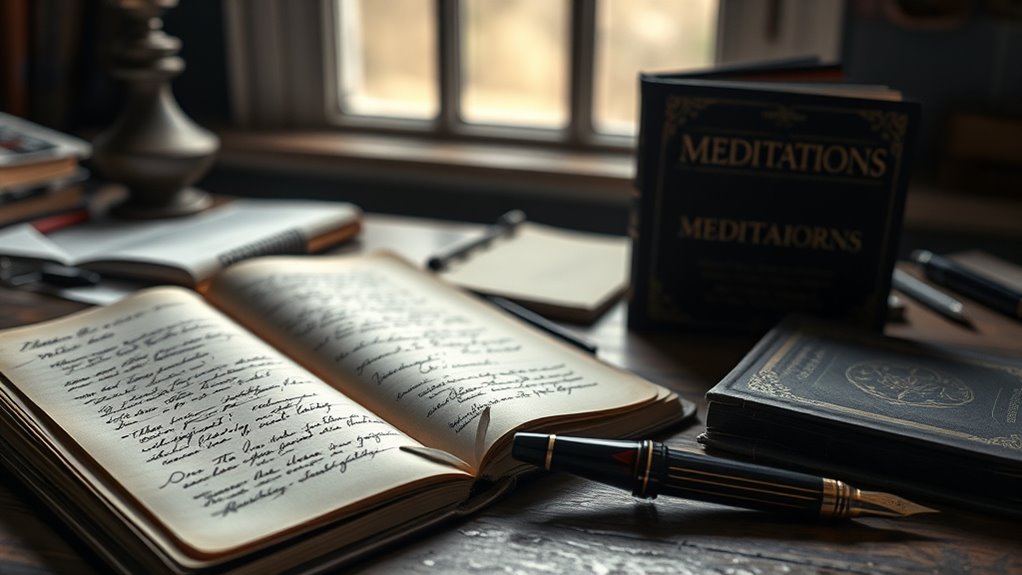Meditations wasn’t meant for publication because Marcus Aurelius wrote it as a private journal focused on personal growth, not public philosophy. He used it for honest self-reflection, capturing his internal struggles and thoughts without concern for external validation. The texts were carefully preserved by scribes, meant for his own use, not for cultural or literary audiences. If you explore further, you’ll discover how these intimate notes continue to inspire today.
Key Takeaways
- It was personal, informal journaling intended for self-reflection, not polished for public consumption.
- The writings reveal vulnerabilities and doubts, making them too raw and unpolished for publication.
- They serve as internal dialogue, focused on self-knowledge rather than instructing or persuading others.
- The style is spontaneous and unstructured, lacking the formal tone typical of public philosophical works.
- Their primary purpose was private self-improvement, not creating a polished, publicly shareable text.
The Personal Nature of Marcus Aurelius’s Reflections

Have you ever wondered why Marcus Aurelius’s writings feel so intimate and raw? It’s because his reflections weren’t meant for others; they were personal notes to himself. He didn’t write with an audience in mind but to clarify his thoughts and reinforce his values.
These writings reveal his vulnerabilities, doubts, and struggles, making them deeply human. You can sense his internal dialogue—conversations with himself about duty, mortality, and virtue. Unlike polished philosophy aimed at teaching others, his notes are raw and unfiltered. His personal reflections demonstrate his desire for authentic self-understanding over public acclaim. Additionally, the internal dialogue captured in his writings offers a rare glimpse into his genuine thought process, unaffected by external expectations. This private journaling allowed him to process life’s challenges honestly, emphasizing the importance of self-awareness. Engaging in such creative practice can similarly foster self-discovery and resilience, as exemplified by his candid notes. Recognizing the value of self-examination can inspire us to pursue our personal growth more intentionally.
Meditations as a Tool for Self-Improvement

Meditations can serve as a powerful tool for your personal growth, offering insights into your strengths and areas for improvement. Practicing mindfulness through these reflections helps you stay present and focused in everyday life. Additionally, incorporating AI-driven insights can enhance your self-awareness by providing personalized feedback, allowing for a more tailored approach to your development. Such tools can also help you understand your behavioral patterns, further supporting your journey toward self-improvement. Recognizing the role of visualization techniques can amplify your ability to manifest your goals and align your mindset with your intentions. Developing a holistic care model that addresses social determinants of health can provide a more comprehensive foundation for your well-being. Understanding the importance of sleep patterns and maintaining a healthy routine can further optimize your overall well-being and mental clarity.
Personal Growth Insights
While meditation is often seen as a simple practice, its true power lies in its ability to foster meaningful personal growth. When you meditate regularly, you develop greater self-awareness, recognizing your thoughts and emotions without judgment. This clarity helps you identify limiting beliefs and patterns that hold you back. Mental clarity and health are significantly enhanced through consistent meditation, supporting long-term personal development. As you deepen your practice, you become more resilient to stress and better equipped to handle life’s challenges. Meditation encourages patience, discipline, and humility, shaping your character over time. It also cultivates gratitude and compassion, transforming how you relate to yourself and others. These insights aren’t just fleeting moments of calm—they serve as a foundation for ongoing self-improvement, guiding you toward a more centered, authentic, and resilient version of yourself. Recognizing the importance of inner resilience can empower you to stay grounded amid life’s uncertainties. Developing emotional regulation through meditation further enhances your ability to navigate complex social and personal situations with calmness and clarity. Additionally, consistent practice can improve self-awareness, enabling you to better understand your responses and triggers in various situations. Moreover, understanding the role of vetted practices ensures that your meditation journey remains safe, effective, and aligned with your personal growth goals.
Mindfulness Practice Benefits
Practicing mindfulness through meditation offers powerful benefits for self-improvement by sharpening your awareness and fostering emotional resilience. It helps you recognize thoughts and feelings without judgment, enabling better control over reactions. Regular practice can reduce stress, enhance focus, and improve overall mental clarity. To understand these benefits better, consider this table:
| Benefit | Description | Impact |
|---|---|---|
| Increased awareness | Heightened perception of thoughts and surroundings | Better decision-making |
| Emotional resilience | Ability to bounce back from setbacks | Reduced anxiety |
| Stress reduction | Calming the mind during challenging moments | Improved well-being |
| Focus enhancement | Improved concentration and attention | Greater productivity |
Additionally, engaging in mindfulness practices can foster a deeper connection to the present moment and support mental clarity, which is often enhanced through meditative postures and breathing techniques, making daily experiences more meaningful. Developing an understanding of neuroplasticity can further motivate you to maintain a consistent practice. Incorporating spiritual principles into your practice can further deepen your mindfulness journey, enriching both your mental and emotional well-being. Understanding the importance of self-awareness can help you develop a more consistent and effective meditation routine.
Inner Peace Cultivation
Achieving inner peace is a key goal for many seeking self-improvement, and meditation serves as an effective tool to help you reach that state. By dedicating time to quiet your mind, you create space for self-reflection and emotional balance.
Meditation encourages you to observe your thoughts without judgment, fostering acceptance and reducing stress. As you practice regularly, you develop a deeper awareness of your inner self, which helps you manage anxiety and cultivate patience. Developing emotional resilience is an essential aspect of this process, enabling you to navigate life’s ups and downs more effectively. Incorporating impactful quotes into your routine can serve as additional sources of inspiration, guiding you toward greater mindfulness. This process isn’t about escaping reality but aligning with it more peacefully. Over time, you’ll notice a greater sense of calm and resilience, empowering you to face life’s challenges with clarity.
Inner peace becomes a foundation for continuous growth, making meditation an essential part of your self-improvement journey. Incorporating thought-provoking dog quotes can also inspire moments of reflection and humor, enriching your meditation practice and personal development. Recognizing the importance of preppy dog names can also add a touch of elegance and personality to your pet, reflecting the same refinement you seek in your personal growth.
The Absence of Audience in the Original Manuscripts

The original manuscripts of meditation texts often reveal a surprising fact: they were created without any consideration of an audience. You might expect these writings to be aimed at specific readers, but they weren’t. Instead, they served personal reflection and growth.
This absence of an audience influences their content in key ways:
- They focus on sincere exploration rather than persuasion or approval.
- The writing style is often informal, spontaneous, and unpolished.
- The texts prioritize internal understanding over external validation.
You can see that these manuscripts were meant for the author’s own use, not for publication or mass consumption. This explains why they often lack structure, polish, and audience-oriented language.
How the Texts Were Preserved and Transmitted

You might notice that these texts were passed down mainly through oral transmission, with teachers memorizing and reciting teachings.
Scribes then used careful preservation techniques to copy manuscripts, ensuring accuracy over generations.
Understanding these methods shows how the teachings survived despite limited printing or widespread dissemination.
Oral Transmission Methods
Since written texts were scarce in ancient times, oral transmission served as the primary method for preserving and passing down teachings. You’d rely on memorization, repetition, and storytelling to keep the teachings alive.
To guarantee accuracy, practitioners often used these methods:
- Repeating teachings aloud multiple times to reinforce memory.
- Engaging in dialogues or debates to clarify understanding.
- Singing or chanting texts during rituals to aid retention.
This oral approach made teachings adaptable to different audiences and contexts, but it also meant that variations naturally arose over time. Despite the lack of written records, these oral methods helped preserve core ideas, ensuring they survived through generations.
It wasn’t until later that texts were written down, adding stability to the teachings.
Manuscript Preservation Techniques
To guarantee ancient teachings endured beyond oral traditions, scribes developed various manuscript preservation techniques that safeguarded texts for future generations. They meticulously copied texts by hand onto durable materials like papyrus, parchment, and vellum, confirming multiple copies existed.
Scribes also employed careful proofreading to minimize errors and used abbreviations or symbols to save space. Sometimes, texts were stored in monasteries or libraries, protected by physical barriers against moisture, pests, and decay. Marginal notes and annotations helped preserve interpretations and clarify meanings.
In some cases, texts were encrypted or hidden to prevent theft or destruction. These preservation methods allowed teachings like Meditations to survive centuries, even as societies transitioned from oral to written traditions. Your careful preservation efforts ensured that these insights reached future readers.
The Distinction Between Private Journals and Public Works

What truly distinguishes a private journal from a public work? It’s the intention behind the writing. In a private journal, your goal is personal reflection, honesty, and internal growth. You’re not concerned with how others will interpret it.
Public works, on the other hand, aim to inform, persuade, or entertain a broader audience. Consider these key differences:
- Purpose: Personal insight versus public communication
- Tone: Candid and raw versus polished and structured
- Audience: Yourself alone versus society at large
Knowing this, you realize that Meditations was meant as a private reflection, not a publication. Its unfiltered nature was designed for personal growth, not for mass consumption.
The Cultural Context of Stoic Philosophy in Ancient Rome

Understanding the cultural backdrop of Stoic philosophy in ancient Rome reveals why these ideas resonated deeply within society. Rome valued discipline, resilience, and self-control, traits that align perfectly with Stoic teachings.
Rome’s values of discipline and resilience made Stoic teachings resonate deeply within society.
As a citizen, you faced constant political pressures, social upheavals, and personal challenges. Stoicism offered a way to maintain inner peace amid chaos by emphasizing virtue, rationality, and acceptance of fate.
The philosophy wasn’t just personal; it influenced leaders, military figures, and thinkers who believed mastering oneself was key to societal stability. Public displays of virtue and moral integrity were highly regarded, making Stoic principles practical guides for everyday life.
This cultural environment fostered a mindset where philosophy wasn’t just theory but a way to navigate the complexities of Roman life.
The Evolution of Meditations From Private Notes to Literary Treasure

Meditations, originally composed as private reflections, gradually transformed into a treasured literary work that has endured through centuries. You mightn’t realize how these personal notes became a timeless classic by evolving through three key stages:
- Private Journals: Marcus Aurelius kept these writings for self-improvement, not publication.
- Manuscript Preservation: His successors preserved and copied the notes, ensuring their survival.
- Public Recognition: Over time, readers recognized their philosophical depth, elevating Meditations to a literary masterpiece.
This transformation wasn’t planned; it was a natural result of others valuing Marcus’s insights. What started as a personal tool for mastery eventually became a source of inspiration for countless generations.
The journey from private notes to enduring treasure highlights how authentic thought can transcend its origins.
Implications for Modern Readers and Philosophical Practice

The journey of Marcus Aurelius’s notes from private reflections to a revered text offers valuable lessons for how modern readers approach philosophy today. It reminds you that philosophy isn’t just about seeking answers but about personal growth and self-awareness.
When you read Meditations, don’t treat it as a set of rigid rules; view it as a guide for introspection. Its original purpose was private, so don’t expect a systematic philosophy—embrace its honesty and vulnerability.
This perspective encourages you to adapt Stoic principles to your life genuinely, rather than using them as dogma. By understanding its context, you learn that philosophy is a dynamic practice, meant to be lived and reflected upon, not just studied passively.
Frequently Asked Questions
Why Did Marcus Aurelius Choose to Keep His Writings Private?
You might wonder why Marcus Aurelius kept his writings private. He saw his work as personal reflections, not meant for public view, so he kept it to himself. His goal was to explore his own Stoic principles and improve himself without external influence or judgment.
How Did Meditations Influence Later Philosophical Thought?
You might think Meditations was just a personal journal, but it secretly shaped Western philosophy. Its emphasis on self-discipline and Stoic virtues influenced thinkers like Nietzsche and existentialists, who questioned the nature of human resilience.
Ironically, a private reflection became a timeless guide, proving that even unintentional messages can inspire generations. So, your private struggles might someday fuel profound philosophical debates—proof that what’s hidden can change the world.
Were There Any Contemporaries Who Criticized Marcus Aurelius’S Reflections?
You might wonder if anyone criticized Marcus Aurelius’s reflections when he wrote Meditations. While few direct critiques exist, some contemporaries and later philosophers questioned Stoic ideas and his personal approach.
You could see critics as challenging his focus on self-discipline and acceptance. Still, Aurelius’s honest, introspective writing resonated with many, influencing both his era and future thinkers, even amid some skepticism.
Did Marcus Aurelius Intend His Writings for Public Dissemination?
You might wonder if Marcus Aurelius intended his writings for public sharing. He didn’t. His reflections were personal, meant to guide himself through Stoic principles, not for publication.
You can see this in their introspective tone and lack of polished structure. He wrote for self-improvement, not fame or public judgment.
How Does Meditations Compare to Other Personal Journals of the Era?
You’ll notice that Meditations differs from other personal journals of the era because it’s more reflective and philosophical, focusing on inner thoughts rather than daily events.
Unlike typical diaries, Marcus Aurelius intended his writings as a tool for self-improvement, not for publication.
You can see a deeper, more structured approach aimed at mastering himself, making Meditations unique and timeless compared to more casual or private journals of his time.
Conclusion
Knowing that Marcus Aurelius wrote over 10,000 notes for himself, it’s clear Meditations was never meant for public eyes. Instead, it was a personal tool for growth, not a polished manuscript. If you see it as a private journal rather than a philosophical masterpiece, you’ll appreciate its raw honesty. Recognizing its original purpose helps you connect more deeply with its timeless wisdom and see how personal reflections can become universal insights.









